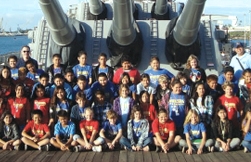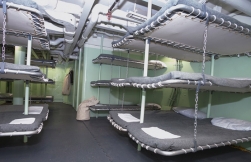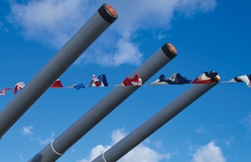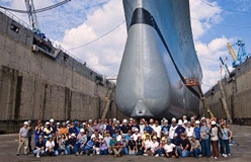By CAPTAIN ROLAND W. FAULK, CHC, USN
Excerpt from a U.S. Naval Institute Oral History interview
Recorded in 1974 at San Diego, California
"...The Battle of Okinawa opened up on Easter Sunday, 1945. The Missouri began by bombarding shore installations, runways and the like. It was evident the battle was going to be hard and long. On shore, the Japanese were well entrenched and the ease with which the amphibious forces made the landings was to prove deceptive, for the Japanese were entrenched at the Naha Line, from which they continued the battle long after it was thought they would be able to do so.
The Naval forces were caught up in the Battle of Okinawa in ways they had not been involved in other island battles. It was obvious that the Japanese knew the battle for Okinawa would be decisive. Consequently, they threw everything they could into the battle including their newest weapon, the Kamikaze.
The carrier task forces were supporting the Okinawa battle by hitting the Japanese Fleet as well as shore installations in Kyushu and in the Inland Sea. Thus, it became a prime goal of the Japanese Air Force to knock out the carriers. The Missourioperated with Task Force 38 but did not become a target for kamikazes until after the torpedo planes and bombers of Task Force 38 had sunk the last of the giant Japanese battleships, Yamato, on April 9, 1945.
Following the sinking of Yamato, it was obvious that for a time, prime targets of Japanese kamikazes were the battleships. Thus on April 11, 1945, we had our first kamikaze hit. I happened to be making my way up the inside ladder of the superstructure to the navigation bridge and just as I stepped out into the cross-passageway I was almost trampled in a rush of officers and men moving from the starboard to the port side of the bridge.
Their action was prompted by the sight of a kamikaze coming from directly astern and apparently headed for the bridge. The young Japanese pilot had obviously chosen to make his run to death by coming in low – just above the water. He was picked up when he was two or three miles astern and all the guns that could be brought to bear were firing at him, not only from Missouri but from other ships in the formation.
The members of the forty millimeter gun crews on the stern described to me the way the plane came in. The pilot had apparently been untouched by the hail of gunfire and was riding his plane in like a jockey on a race horse - squatting in his seat. He hit just abaft of turret three, shearing off the port wing of the plane which flew a hundred feet forward and landed behind a five inch gun mount at an intake vent which provided ventilation to the fire rooms. His torso fell on the main deck and the whole rest of his plane and portions of his body went into the water - all without a bomb exploding.
The next morning a military funeral was conducted for the Japanese pilot who appeared to be a young man about eighteen or nineteen years of age. To some of the crew who grumbled because military honors were rendered, I reminded them that a dead enemy is no longer an enemy. As far as I was aware, this was the only instance of its kind in World War II where such honors were rendered under such circumstances.







